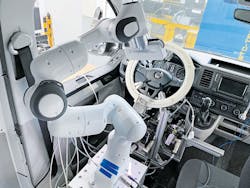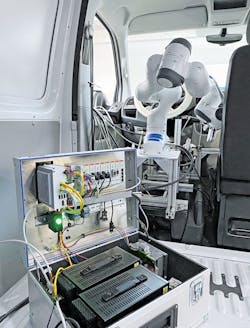Automakers need test-bench technology that is fast, flexible and cost-effective. Researchers at Kempten University built such a test bench for ABT e-Line GmbH. It is used to evaluate the capabilities of traditional light commercial vehicles which ABT converts into electric-powered versions, in partnership with Volkswagen Commercial Vehicles.
“In the case of electric vehicles, the aim is to test whether HVAC subsystems, which draw power from the high-voltage battery, influence the vehicle’s important functions, such as switching on, switching off and driving,” says Florian Zerbes, a research assistant at Kempten. “This involves specifying a test cycle that repeatedly starts, stops and accelerates the vehicle independently over several hours or even days. During the test, test bench and vehicle data is recorded so it can be analyzed.”
During the test, output motors flanged to the vehicle wheels provide resistance to the turning wheels, which simulates driving on a road. A robot in the vehicle turns the ignition key, moves the gearshift, and operates various buttons, such as those for climate control. Linear motors press the accelerator and brake pedals, while a motor turns the steering wheel. A second robot outside the vehicle plugs and unplugs various cables from charging sockets. Sensors also record currents and voltages in the vehicle’s wiring harnesses for analysis.
READ MORE: Redesigned Testing Machine Set Up to Gather and Use Big Data
The Beckhoff control platform—a C6030 ultra-compact industrial PC with TwinCAT 3 automation software—communicates, coordinates and controls individual components and the vehicle via a CAN bus. A range of different tests, all with different procedures, can be carried out. And nine EL6751 EtherCAT Terminals serve as single-channel communication interfaces, which make it easy for the test bench to work with any CAN and CANopen devices.
During the test, the vehicle experiences real-world driving conditions. The drive test bench moves the wheels according to the simulated torques and accommodates steering movements of the front wheels. The driver’s actions are simulated by another set of corresponding actuators which are done mainly by industrial robots. The surroundings are also simulated, along with how the vehicle communicates with the environment such as using GPS. In addition to developing the test bench, the Kempten team also created a digital twin of it. This simplifies pre-commissioning the test bench.
To keep the test bench as cost-effective as possible, Kempten designers used standard industrial components such as converters, motors and controls. The test equipment also had to be quickly installed and removed from any vehicle being tested, so it had to be adaptable.
“We developed a test bench that can test most vehicle functions using standard vehicle interfaces,” says Andreas Stiegelmeyr, professor of mechanical engineering at Kempten. “This makes it possible to test functions with a high degree of connectivity with minimal effort, regardless of vehicle type.”
The team chose to go with Beckhoff as the central-control supplier because it offers many different interfaces for industrial components, according to Zerbes. “What’s more, the controls can be easily expanded by adding EtherCAT I/O terminals and then distributed throughout a space, thanks to the exceptional freedom of EtherCAT topology. The sheer volume of hardware and software products available means many measurement and control tasks can be completed with minimal effort,” he says. “And to top it off, Beckhoff’s PC-based control provides a cost advantage over systems from the automotive sector.”
Test sequences are written in Structured Text using a specially developed toolchain and generated with MATLAB/Simulink. This makes it possible to use TwinCAT and Simulink together effectively. “Blocks that already contain the information for the hardware links can be generated automatically in Simulink,” says Zerbes. “When compiling the respective model, corresponding hardware links are automatically set by the TwinCAT Automation Interface and a link layer is created between the model and the hardware.”
The toolchain lets:
- Simulink models be created with little effort.
- Different databases be used without problems.
- The connection to the hardware be automated and configured in the Simulink model.
- Users benefit from a straightforward interface.
The current focus of the toolchain is on the CAN bus so that CAN message blocks can be created quickly via a DBC file, for example. Blocks like this can then be connected to the rest of the model and the hardware connection configured in Simulink. Users can configure individual messages via a GUI. Once the Simulink model is created, it can be easily connected to TwinCAT via the toolchain. Users just have to decide which Simulink models link to which TwinCAT projects.
Otherwise, everything runs automatically. At the same time, users can adjust TwinCAT projects in terms of the hardware or the implementation of PLC projects.



